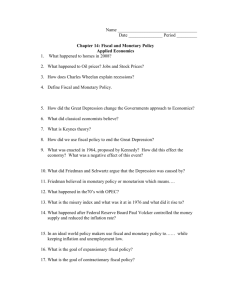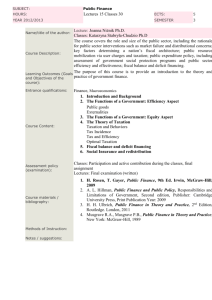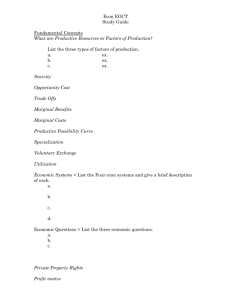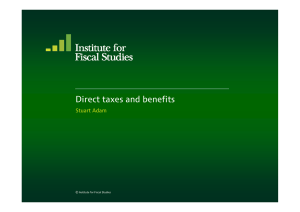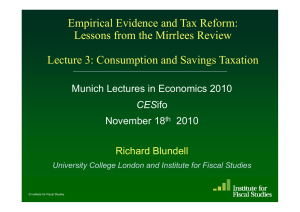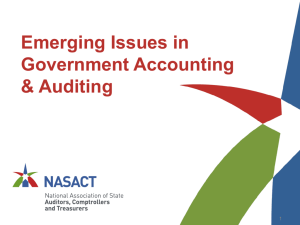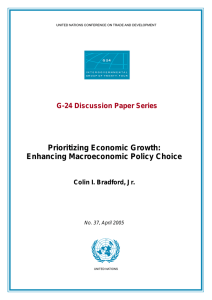Macroeconomics and Public Finance
advertisement
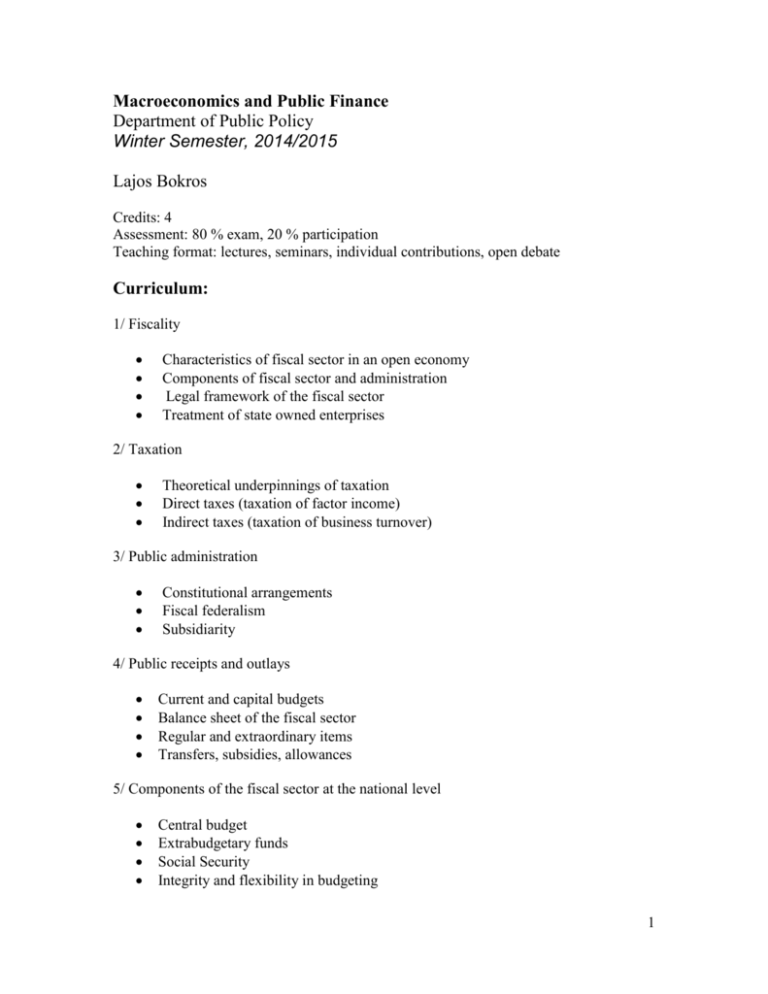
Macroeconomics and Public Finance Department of Public Policy Winter Semester, 2014/2015 Lajos Bokros Credits: 4 Assessment: 80 % exam, 20 % participation Teaching format: lectures, seminars, individual contributions, open debate Curriculum: 1/ Fiscality Characteristics of fiscal sector in an open economy Components of fiscal sector and administration Legal framework of the fiscal sector Treatment of state owned enterprises 2/ Taxation Theoretical underpinnings of taxation Direct taxes (taxation of factor income) Indirect taxes (taxation of business turnover) 3/ Public administration Constitutional arrangements Fiscal federalism Subsidiarity 4/ Public receipts and outlays Current and capital budgets Balance sheet of the fiscal sector Regular and extraordinary items Transfers, subsidies, allowances 5/ Components of the fiscal sector at the national level Central budget Extrabudgetary funds Social Security Integrity and flexibility in budgeting 1 6/ Financing and managing human infrastructure Pension systems Health care finance and management Public education Higher education 7/ Pension systems Publicly managed unfunded systems (PAYG) Privately or publicly managed funded systems Occupational pension schemes Regulation and supervision of pension funds 8/ Health care (HC) Reasons of asymmetric information in HC Demand and supply management in HC General practitioners, out-and in-patient care Multipillar solutions in HC finance and administration 9/ Education Distinction between public and higher education Role of local governments in public education Higher education in a competitive market 10/ Financing subsovereign governments The four models of subsovereign finance Split and own revenues, transfers, subsidies Joint tasks financed by subsovereign alliances Asset and liability management 11/ The Open Economy Markets of good and services Financial and factor markets The four sectors of and open economy 12/ The Balance of Payments Current and capital accounts Change in short-term net foreign assets (reserves) 2 13/ The Flow of Funds Saving and investment position of various sectors Disposable income and domestic use of income Fiscal deficit and public debt External deficit and national debt Economic policy consequences 14/ Exchange rate regimes in an open economy Significance of e/r in monetary policy Free float and managed float Fixed e/r regimes Currency board arrangements 15/ Monetary and fiscal policy mix The impact of fiscal contraction and expansion The impact of monetary restrictions and easing The unholy trinity in monetary management Crisis management with macropolicy tools 16/ Crisis economics The subprime crisis in the US Misguided monetary policy in the US Ineffective regulation and supervision Toxic assets and international contagion Economic policy failures in the eurozone 17/ Structural weaknesses in the financial sector The concepts of liquidity and solvency Asset classification and risk management Resolution mechanisms in banking Prudential regulation and supervision 18/ Crisis management in transition economies Structural weaknesses of transition economies Impact of the European Union Impact of institutional arrangements Macropolicy alternatives in transition 3 Compulsory reading 1/ Public Finance Reform during Transition. The Experience of Hungary edited by Lajos Bokros and Jean-Jacques Dethier, The World Bank, 1996 Chapter 1. The General Trends and the Philosophy of Public Finance Reforms Chapter 14. Wages and Employment in the Public Sector Chapter 15. Sorting Out Intergovernmental Roles and Responsibilities 2/ Second Wave of Polish Reforms edited by Lena Kolarska-Bobinska, Institute of Public Affairs, Warsaw, 2000 Chapter 2. Territorial Government Reform Chapter 3. Healthcare Reform Chapter 4. Social Security Reform: Old Age and Disability Pensions Chapter 5. Changes in Education – Ideas and Conditions Chapter 6. Changes in Higher Education 3/ Averting the Old Age Crisis. A World Bank Policy Research Report Oxford University Press,1994 Chapter 4. Public Pension Plans Chapter 5. Occupational Pension Plans Chapter 6. Personal Savings Plans – Becoming Mandatory Chapter 7. Putting the Pillars Together 4/ Health Economics in Development Philip Musgrove, editor, The World Bank, Washington DC, 2004 Chapter 2. Public and Private Roles in Health Chapter 9. Criteria for Public Spending on Health 5/ Bruce F. Davie and Bruce F. Duncombe: Public Finance Holt, Rinehart & Winston, Inc. 1972 Chapter 7. Taxes and Resource Allocation 6/ Olivier Blanchard: Macroeconomics. MIT Prentice Hall, 2003 The Open Economy Chapter 18. Openness in Goods and Financial Markets Chapter 19. The Goods Market in an Open Economy Chapter 20. Output, the Interest Rate, and the Exchange Rate Chapter 21. Exchange Rate Regimes 4 7/ N. Gregory Mankiw: Macroeconomics. Harvard University Worth Publischers, 2003 Chapter 5. The Open Economy 8/ Robert Holzmann and Richard Hinz: Old Age Income Support in the 21st Century The World Bank, 2005 Chapter 1. The Need for Reform Chapter 2. Conceptual Foundations of the World Bank’s Perspective 9/ Liam Ebrill, Michael Keen, Jean-Paul Bodin, and Victoria Summers: The Modern VAT. International Monetary Fund, 2001 Chapter 1. The Nature, Importance, and Spread of the VAT Chapter 2. Basic Design Issues 10/ Nicholas Barr: Labor Markets and Social Policy in Central and Eastern Europe The Accession and Beyond. The World Bank, 2005 11/ Raguram G. Rajan: Fault Lines Princeton University Press, 2010 Chapter 2. Exporting to grow Chapter 3. Flighty foreign financing Chapter 5. From bubble to bubble Chapter 8. Reforming finance 12/ Martin Wolf: Fixing Global Finance The Johns Hopkins University Press, 2008 Chapter 2. Blessings and perils of liberal finance Chapter 3. Financial crises int he era of globalization Chapter 4. From crises to imbalances Chapter 7. Toward global reform 13/ Nouriel Roubini – Stephen Mihn: Crisis Economics Allen Lane, 2010 Chapter 2. Crisis economics Chapter 4. Things fall apart Chapter 9. Radical remedies 5





